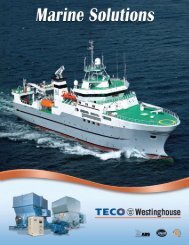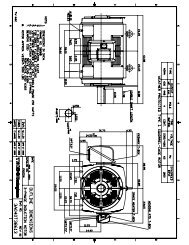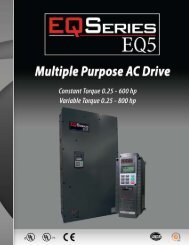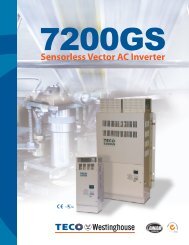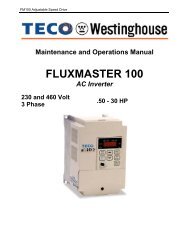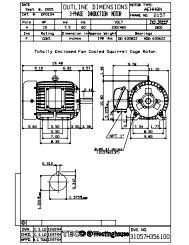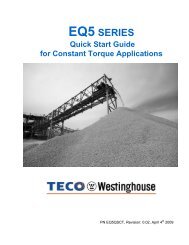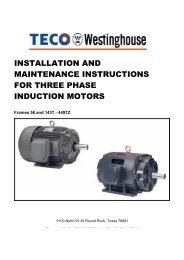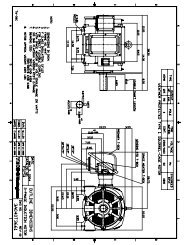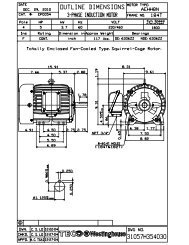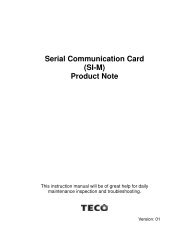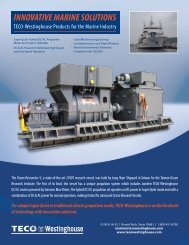EQ7 Series Instruction Manual - TECO-Westinghouse Motor Company
EQ7 Series Instruction Manual - TECO-Westinghouse Motor Company
EQ7 Series Instruction Manual - TECO-Westinghouse Motor Company
Create successful ePaper yourself
Turn your PDF publications into a flip-book with our unique Google optimized e-Paper software.
• Acceleration/Deceleration pattern (H07)<br />
H07 specifies the acceleration and deceleration patterns (patterns to control output frequency).<br />
Data for<br />
H07<br />
0<br />
1<br />
2<br />
3<br />
Acceleration/<br />
deceleration<br />
pattern<br />
Linear<br />
S-curve<br />
(Fixed)<br />
S-curve<br />
(Adjustable)<br />
Curvilinear<br />
Motion<br />
The inverter runs the motor with the constant acceleration and<br />
deceleration.<br />
To reduce an impact that Fixed:<br />
acceleration/deceleration The acceleration/deceleration rate<br />
would make on the machine, to be applied to all of the four<br />
the inverter gradually<br />
inflection zones is fixed at 5% of<br />
accelerates or decelerates the maximum frequency.<br />
the motor in both the starting<br />
Adjustable:<br />
and ending zones of<br />
acceleration or deceleration. The acceleration/deceleration rate<br />
can be arbitrarily specified for each<br />
of the four inflection zones.<br />
Acceleration/deceleration is linear below the base frequency<br />
(constant torque) but it slows down above the base frequency to<br />
maintain a certain level of load factor (constant output).<br />
This acceleration/deceleration pattern allows the motor to accelerate<br />
or decelerate with the maximum performance of the motor.<br />
Function<br />
code<br />
-<br />
-<br />
H57<br />
H58<br />
H59<br />
H60<br />
-<br />
S-curve acceleration/deceleration<br />
To reduce an impact that acceleration/deceleration would make on the machine, the inverter gradually accelerates<br />
or decelerates the motor in both the starting and ending zones of acceleration or deceleration. Two types of<br />
S-curve acceleration/deceleration rates are available; applying 5% (fixed) of the maximum frequency to all of the<br />
four inflection zones, or specifying adjustable rate for each of the four zones with function codes H57 to H60. The<br />
reference acceleration/deceleration time determines the duration of acceleration/deceleration in the linear period;<br />
hence, the actual acceleration/deceleration time is longer after applying S-curve.<br />
Acceleration<br />
Deceleration<br />
Starting zone Ending zone Starting zone Ending zone<br />
S-curve (Fixed) 5% 5% 5% 5%<br />
S-curve (Adjustable)<br />
Setting range: 0 to<br />
100%<br />
H57<br />
Acceleration rate<br />
for the 1st S-curve<br />
(Leading edge)<br />
H58<br />
Acceleration rate<br />
for the 2nd<br />
S-curve<br />
(Trailing edge)<br />
H59<br />
Deceleration rate<br />
for the 1st<br />
S-curve<br />
(Leading edge)<br />
H60<br />
Deceleration rate<br />
for the 2nd<br />
S-curve<br />
(Trailing edge)<br />
<br />
Acceleration or deceleration time (s) = (2 5/100 + 90/100+ 2 5/100) (reference acceleration or deceleration time)<br />
= 1.1 (reference acceleration or deceleration time)<br />
<br />
Acceleration or deceleration time (s) = (2 10/100 + 70/100 + 2 20/100) (reference acceleration or deceleration time)<br />
= 1.3 (reference acceleration or deceleration time)<br />
4-39



